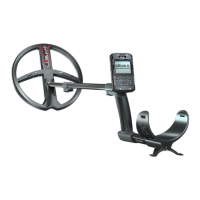17
DISCRIMINATION > EXPERT / MENU
TONES
SILENCER
MENU
90
B.CAPS
T.ID G.ID
A few large iron objects or unusual shapes are often more difcult to discriminate.
Iron objects often generate a few audible remnants of broken or inconsistent sig-
nals (crackling). Increasing the silencer applies a lter which eliminates the crack-
ling caused by ferrous items.
2
SENSITIVITY
MENU
90
93
T.ID G.ID
Determines the device’s sensitivity level from 0 to 99.
The most commonly used sensitivity levels range from 70 to 90. Reduce the level
in trashy areas or close to power lines, fences, radio-relay stations, etc.
Do not test your device indoors as there is considerable electromagnetic and met-
al interference in urban environments (EMI).
Sensitivity (general sensitivity)
FREQ. SHIFT
IRON VOLUME
I 2
I 3
DISCRI IAR
EXPERT
MENU
90
78
2
T.ID G.ID
THRESHOLD
MENU
90
2
T.ID G.ID
Programs 8 GOLD FIELD and 9 RELIC FIELD use another discrimination method,
called IAR (Iron Amplitude Rejection). This allows rejection of ferrous items accord-
ing to their distance from the coil.
0 = no rejection 3 = Shallow Ferrous rejection 5 = Shallow and deeper Ferrous
rejection
This feature is used to set the amplitude of the background sound threshold.
Adjust it from 0 to 20.
IAR Discrimination (Prg. 8 / 9)
Threshold (Only with Pitch mode ON)
SENSITIVITY
DISCRI IAR
FREQ SHIFT
SENSITIVITY
I 95
I 0
I 3
I 95
Select Tone break 1 or 2 with .
Adjust the values
-
and
+
.
If several targets with different conductivity levels are a problem, you can activate
two other notches: N2 and N3. Use
to select N2 or N3 and adjust as for N1.
You will notice that the notched zones are grayed out in the conductivity bar on the
main search screen.
M - NOTCH
MENU
T.BREAK1
28
N1
T.BREAK2
46
65
T.ID G.ID
90
Gold nuggets or relics items buried deeply in mineralized ground can generate a similar signal to a ferrous
item, so in this case it is better to reduce the IAR discrimination level.
Multi-Notch ...
Silencer

